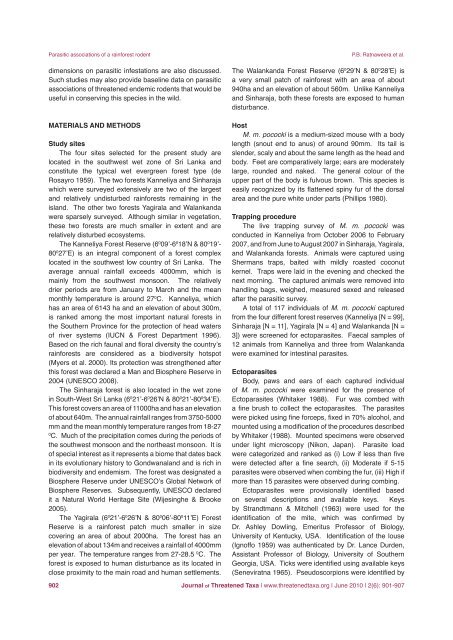Parasitic associations of a threatened Sri Lankan rainforest rodent ...
Parasitic associations of a threatened Sri Lankan rainforest rodent ...
Parasitic associations of a threatened Sri Lankan rainforest rodent ...
Create successful ePaper yourself
Turn your PDF publications into a flip-book with our unique Google optimized e-Paper software.
<strong>Parasitic</strong> <strong>associations</strong> <strong>of</strong> a <strong>rainforest</strong> <strong>rodent</strong>dimensions on parasitic infestations are also discussed.Such studies may also provide baseline data on parasitic<strong>associations</strong> <strong>of</strong> <strong>threatened</strong> endemic <strong>rodent</strong>s that would beuseful in conserving this species in the wild.MATERIALS AND METHODSStudy sitesThe four sites selected for the present study arelocated in the southwest wet zone <strong>of</strong> <strong>Sri</strong> Lanka andconstitute the typical wet evergreen forest type (deRosayro 1959). The two forests Kanneliya and Sinharajawhich were surveyed extensively are two <strong>of</strong> the largestand relatively undisturbed <strong>rainforest</strong>s remaining in theisland. The other two forests Yagirala and Walankandawere sparsely surveyed. Although similar in vegetation,these two forests are much smaller in extent and arerelatively disturbed ecosystems.The Kanneliya Forest Reserve (6 0 09’-6 0 18’N & 80 0 19’-80 0 27’E) is an integral component <strong>of</strong> a forest complexlocated in the southwest low country <strong>of</strong> <strong>Sri</strong> Lanka. Theaverage annual rainfall exceeds 4000mm, which ismainly from the southwest monsoon. The relativelydrier periods are from January to March and the meanmonthly temperature is around 27 0 C. Kanneliya, whichhas an area <strong>of</strong> 6143 ha and an elevation <strong>of</strong> about 300m,is ranked among the most important natural forests inthe Southern Province for the protection <strong>of</strong> head waters<strong>of</strong> river systems (IUCN & Forest Department 1996).Based on the rich faunal and floral diversity the country’s<strong>rainforest</strong>s are considered as a biodiversity hotspot(Myers et al. 2000). Its protection was strengthened afterthis forest was declared a Man and Biosphere Reserve in2004 (UNESCO 2008).The Sinharaja forest is also located in the wet zonein South-West <strong>Sri</strong> Lanka (6 0 21’-6 0 26’N & 80 0 21’-80 0 34’E).This forest covers an area <strong>of</strong> 11000ha and has an elevation<strong>of</strong> about 640m. The annual rainfall ranges from 3750-5000mm and the mean monthly temperature ranges from 18-270C. Much <strong>of</strong> the precipitation comes during the periods <strong>of</strong>the southwest monsoon and the northeast monsoon. It is<strong>of</strong> special interest as it represents a biome that dates backin its evolutionary history to Gondwanaland and is rich inbiodiversity and endemism. The forest was designated aBiosphere Reserve under UNESCO’s Global Network <strong>of</strong>Biosphere Reserves. Subsequently, UNESCO declaredit a Natural World Heritage Site (Wijesinghe & Brooke2005).The Yagirala (6 0 21’-6 0 26’N & 80 0 06’-80 0 11’E) ForestReserve is a <strong>rainforest</strong> patch much smaller in sizecovering an area <strong>of</strong> about 2000ha. The forest has anelevation <strong>of</strong> about 134m and receives a rainfall <strong>of</strong> 4000mmper year. The temperature ranges from 27-28.5 0 C. Theforest is exposed to human disturbance as its located inclose proximity to the main road and human settlements.P.B. Ratnaweera et al.The Walankanda Forest Reserve (6 0 29’N & 80 0 28’E) isa very small patch <strong>of</strong> <strong>rainforest</strong> with an area <strong>of</strong> about940ha and an elevation <strong>of</strong> about 560m. Unlike Kanneliyaand Sinharaja, both these forests are exposed to humandisturbance.HostM. m. pococki is a medium-sized mouse with a bodylength (snout end to anus) <strong>of</strong> around 90mm. Its tail isslender, scaly and about the same length as the head andbody. Feet are comparatively large; ears are moderatelylarge, rounded and naked. The general colour <strong>of</strong> theupper part <strong>of</strong> the body is fulvous brown. This species iseasily recognized by its flattened spiny fur <strong>of</strong> the dorsalarea and the pure white under parts (Phillips 1980).Trapping procedureThe live trapping survey <strong>of</strong> M. m. pococki wasconducted in Kanneliya from October 2006 to February2007, and from June to August 2007 in Sinharaja, Yagirala,and Walankanda forests. Animals were captured usingShermans traps, baited with mildly roasted coconutkernel. Traps were laid in the evening and checked thenext morning. The captured animals were removed intohandling bags, weighed, measured sexed and releasedafter the parasitic survey.A total <strong>of</strong> 117 individuals <strong>of</strong> M. m. pococki capturedfrom the four different forest reserves (Kanneliya [N = 99],Sinharaja [N = 11], Yagirala [N = 4] and Walankanda [N =3]) were screened for ectoparasites. Faecal samples <strong>of</strong>12 animals from Kanneliya and three from Walankandawere examined for intestinal parasites.EctoparasitesBody, paws and ears <strong>of</strong> each captured individual<strong>of</strong> M. m. pococki were examined for the presence <strong>of</strong>Ectoparasites (Whitaker 1988). Fur was combed witha fine brush to collect the ectoparasites. The parasiteswere picked using fine forceps, fixed in 70% alcohol, andmounted using a modification <strong>of</strong> the procedures describedby Whitaker (1988). Mounted specimens were observedunder light microscopy (Nikon, Japan). Parasite loadwere categorized and ranked as (i) Low if less than fivewere detected after a fine search, (ii) Moderate if 5-15parasites were observed when combing the fur, (iii) High ifmore than 15 parasites were observed during combing.Ectoparasites were provisionally identified basedon several descriptions and available keys. Keysby Strandtmann & Mitchell (1963) were used for theidentification <strong>of</strong> the mite, which was confirmed byDr. Ashley Dowling, Emeritus Pr<strong>of</strong>essor <strong>of</strong> Biology,University <strong>of</strong> Kentucky, USA. Identification <strong>of</strong> the louse(Ign<strong>of</strong>fo 1959) was authenticated by Dr. Lance Durden,Assistant Pr<strong>of</strong>essor <strong>of</strong> Biology, University <strong>of</strong> SouthernGeorgia, USA. Ticks were identified using available keys(Seneviratna 1965). Pseudoscorpions were identified by902Journal <strong>of</strong> Threatened Taxa | www.<strong>threatened</strong>taxa.org | June 2010 | 2(6): 901-907
















